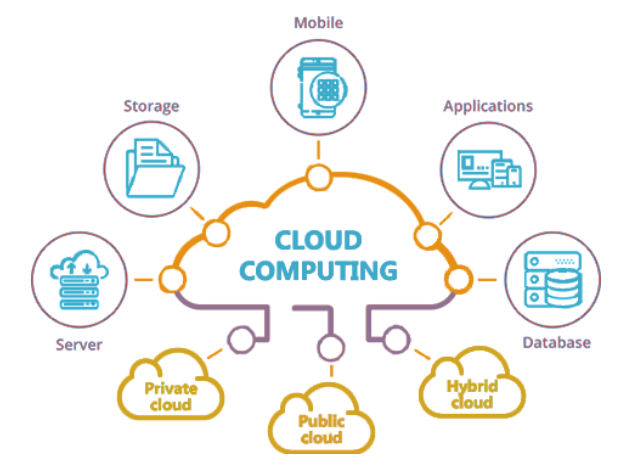Navigating the Digital Sky: Exploring the Wonders of Cloud Computing

Introduction
In the ever-evolving landscape of technology, cloud computing has emerged as a transformative force, reshaping the way businesses, individuals, and organizations interact with data and applications. It has become an integral part of our digital lives, influencing everything from how we store and access information to how enterprises conduct their operations. In this comprehensive article, we will delve into the intricate world of cloud computing, exploring its fundamental principles, diverse models, key players, benefits, challenges, and the profound impact it has on our digital ecosystem.
Understanding Cloud Computing
- The Essence of Cloud Computing
At its core, cloud computing refers to the delivery of computing services—including servers, storage, databases, networking, software, analytics, and intelligence—over the internet. These services are provided by cloud service providers (CSPs) who maintain vast data centers with the infrastructure required to deliver computing resources remotely.
- Key Characteristics
Cloud computing exhibits several defining characteristics:
2.1. On-Demand Self-Service:
Users can provision and manage computing resources as needed, without requiring human intervention from the service provider.
2.2. Broad Network Access:
Cloud services are accessible over the internet from a wide range of devices, including laptops, smartphones, and tablets.
2.3. Resource Pooling:
Computing resources are pooled and shared among multiple users, optimizing utilization and efficiency.
2.4. Rapid Elasticity:
Cloud resources can be quickly scaled up or down to meet changing demands, ensuring cost-effectiveness.
2.5. Measured Service:
Users are billed for the resources they consume, often on a pay-as-you-go basis, which allows for cost control and transparency.
- Service Models
Cloud computing offers a spectrum of service models tailored to different needs:
3.1. Infrastructure as a Service (IaaS):
IaaS provides virtualized computing resources over the internet. Users can rent virtual machines, storage, and networking infrastructure, enabling them to run and manage their own operating systems and applications.
3.2. Platform as a Service (PaaS):
PaaS offers a platform that includes not only infrastructure but also development tools and services to build, deploy, and manage applications. Users can focus on coding and application logic without worrying about the underlying infrastructure.
3.3. Software as a Service (SaaS):
SaaS delivers fully functional software applications over the internet on a subscription basis. Users can access these applications through a web browser without the need for installation or maintenance.
- Deployment Models
Cloud computing can be deployed in various ways to meet specific requirements:
4.1. Public Cloud:
Services are offered to the public by a CSP and are accessible over the internet. Public clouds are highly scalable and cost-effective but may have limited customization options.
4.2. Private Cloud:
Private clouds are dedicated to a single organization and may be hosted on-premises or by a third-party provider. They offer greater control, security, and customization but require higher maintenance.
4.3. Hybrid Cloud:
Hybrid clouds combine elements of both public and private clouds, allowing data and applications to be shared between them. This model provides flexibility and optimization of resources.
4.4. Multi-Cloud:
Multi-cloud strategies involve using multiple cloud providers to meet various needs. This approach can enhance reliability, reduce vendor lock-in, and optimize costs.
The Key Players
Several major CSPs dominate the cloud computing market, each offering a comprehensive suite of services and solutions:
- Amazon Web Services (AWS): AWS, a subsidiary of Amazon, is the largest and most widely adopted cloud platform, offering a vast array of services, from computing and storage to machine learning and analytics.
- Microsoft Azure: Microsoft’s Azure platform provides a wide range of cloud services and is known for its strong integration with Microsoft products like Windows Server and Office 365.
- Google Cloud Platform (GCP): Google’s cloud offering is renowned for its data analytics and machine learning capabilities, as well as its robust infrastructure.
- IBM Cloud: IBM’s cloud services focus on hybrid and multiload solutions, with strengths in AI and blockchain.
- Oracle Cloud: Oracle specializes in cloud databases and enterprise software, offering cloud infrastructure and applications.
- Alibaba Cloud: As the leading cloud provider in China, Alibaba Cloud is rapidly expanding its global presence and offers a comprehensive suite of services.
- Salesforce: Known for its customer relationship management (CRM) software, Salesforce also provides cloud-based applications and platforms for businesses.
Benefits of Cloud Computing
Cloud computing offers a multitude of advantages, making it a compelling choice for businesses and individuals alike:
- Cost-Efficiency: Cloud services eliminate the need for upfront capital investments in hardware and reduce ongoing operational costs. Users pay only for the resources they consume.
- Scalability: Cloud resources can be quickly scaled up or down to accommodate changing demands, allowing businesses to efficiently respond to market fluctuations.
- Accessibility: Cloud services are accessible from anywhere with an internet connection, enabling remote work and collaboration.
- Flexibility: Users can choose from a wide range of services and configurations to suit their specific needs, from basic storage to complex machine learning models.
- Reliability: Leading CSPs offer high availability and redundancy, minimizing downtime and ensuring data resilience.
- Security: Cloud providers invest heavily in security measures, including data encryption, threat detection, and identity management, to protect user data.
- Innovation: Cloud computing facilitates rapid development and deployment of applications, fostering innovation and reducing time-to-market.
Challenges and Concerns
While cloud computing offers numerous benefits, it also presents challenges and concerns that must be addressed:
- Security and Privacy: Storing data off-premises raises security and privacy concerns. Organizations must implement robust security measures and comply with data protection regulations.
- Data Transfer and Bandwidth Costs: Uploading and downloading large volumes of data to and from the cloud can incur significant bandwidth costs and time delays.
- Downtime: While CSPs strive for high availability, occasional service outages can disrupt operations. Redundancy and disaster recovery plans are essential.
- Vendor Lock-In: Moving data and applications between cloud providers can be complex and costly, potentially leading to vendor lock-in.
- Compliance: Businesses must navigate a complex landscape of regulatory requirements when using cloud services, particularly in highly regulated industries.



